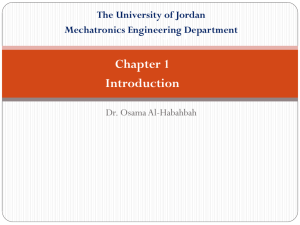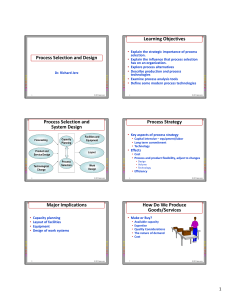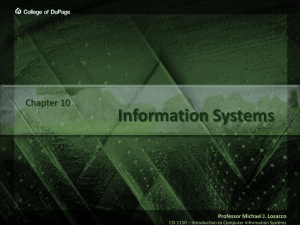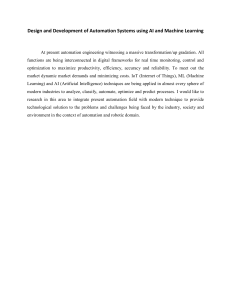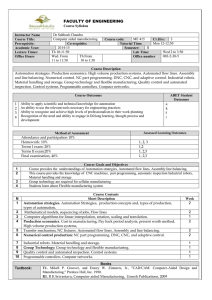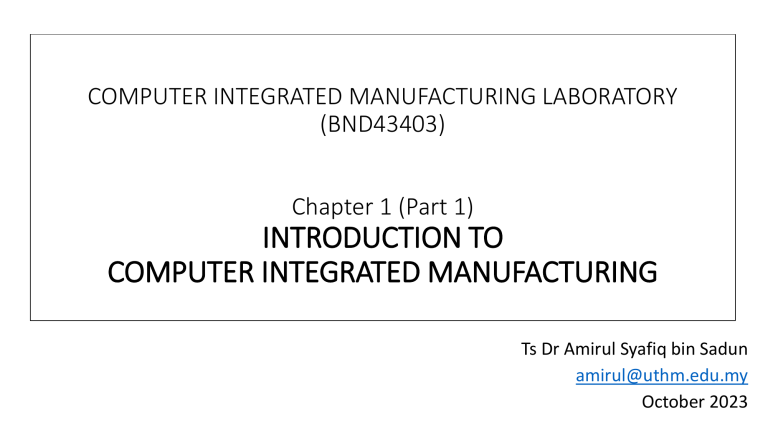
COMPUTER INTEGRATED MANUFACTURING LABORATORY (BND43403) Chapter 1 (Part 1) INTRODUCTION TO COMPUTER INTEGRATED MANUFACTURING Ts Dr Amirul Syafiq bin Sadun amirul@uthm.edu.my October 2023 Malaysia Manufacturing Sector Production Systems • A production system is a collection of people, equipment, and procedures organized to perform the manufacturing operations of a company. Production Systems Two major components: Facilities : The physical facilities of the production system include the equipment, the way of the equipment is laid out and the factory in which the equipment is located Manufacturing support system : These are procedures used by the company to manage production and to solve the technical and logistics problems encountered in ordering materials, moving the work through the factory and ensuring that products meet quality standards. Product design and certain business functions are included in the manufacturing support systems Direct labor people (blue-collar workers) are responsible for operating the facilities, and professional staff people (white-collar workers) are responsible for manufacturing support systems Facilities • The facilities in the production system consist of the factory, production machines and tooling, material handling equipment, inspection equipment, and computer systems that control the manufacturing operations. • Include the plant layout, which is the way the equipment is physically arranged in the factory. The equipment is usually organized into manufacturing systems, which are the logical groupings of equipment and workers that accomplish the processing and assembly operations on parts and products made by the factory. • Manufacturing systems can be individual work cells consisting of a single production machine and a worker assigned to that machine. More complex manufacturing systems consist of collections of machines and workers, for example, a production line. Facilities (cont’d) Manual Work Systems Worker-Machine Systems Automated Systems • Three basic categories of human participation 1. Manual Work Systems A manual work system consist of one or more workers performing one or more tasks without the aid of powered tools (Using Hand). Production tasks commonly require the use of hand tolls, such as screwdrivers and hammers Examples: - A machinist using a file to round the edges of a rectangular part that has just been milled - A quality control inspector using a micrometer to measure the diameter of a shaft - A material handling worker using a dolly to move cartons in a warehouse - A team of assembly workers putting together a piece of machinery using hand tools Facilities (cont’d) 2. Worker-Machine Systems In a worker-machine system, a human worker operates powered equipment, such as a machine tool or other production machine (most widely used manufacturing systems) Worker-machine systems include combinations of one or more workers and one or more pieces of equipment. Examples: - A machinist operating an engine lathe to fabricate a part for a product - A fitter and industrial robot working together in an arc-welding work cell - A crew of workers operating a rolling mill that converts hot steel slabs into flat plates - A production line in which the products are moved by mechanized conveyor and the workers at some of the stations use power tools to accomplish their processing or assembly tasks Humans vs Machines Facilities (cont’d) 3. Automated Systems An automated system is one in which a process is performed by a machine without the direct participation of a human worker Automation is implemented using a program of instructions combined with a control system that executes the instructions Power is required to drive the process and to operate the program and control system Two levels of automation: 1) SEMIAUTOMATED A portion of the work cycle under some form of program control, and a human worker tends to the machine for the remainder of the cycle, by loading and unloading it, or by performing some other task each cycle 2) A FULLY AUTOMATED MACHINE Operate without human attention for an extended period of time. Extended period of time means longer than one work cycle; a worker is not required to be present during each cycle. Instead, the worker may need to tend the machine every tenth cycle or every hundredth cycle. Example of this operation is found in many injection molding plants, where the molding machines run on automatic cycles, but periodically the molded parts at the machine must be collected by a worker. Facilities (cont’d) (a) Manual Work System, (b) Worker-Machine System and (c) Fully Automated System Manufacturing Support System • Manufacturing Support System is a people and procedures by which a company manages its production operations. Most of these support systems do not directly contact the product, but they plan and control its progress through the factory Manufacturing Support System • The activities • Business functions (sales and marketing, sales forecasting, order entry and customer billing) • Product Design ( customer’s product design, manufacturer’s product design, product development and design) • Manufacturing Planning ( information and documentations of product design flows into the manufacturing planning function that includes process planning, master scheduling, material requirements planning and capacity planning) • Manufacturing Control ( managing and controlling the physical operations in the factory to implement the manufacturing plans. The flow of information is from planning to control that includes shop floor control, inventory control and quality control) Sequence of information processing activities Automation in production systems Production system are likely to be automated, whereas others will be operated manually or clerically. SME Mostly manual The automated elements of the production system: 1. Automation of the manufacturing systems in the factory 2. Computerization of the manufacturing support systems REFRESH Automation Element TASK 1 : First Grouping Task Find examples of manual work processes, semiautomated processes, and fully automated processes. Record and submit a video via Google Form. Video Format: i. Find any social media video for each process type, with a length not exceeding 10 minutes each. ii. Record a 1-minute presentation in which you briefly explain each video, highlighting the significant parts only. Submission Link: COMPUTER INTEGRATED MANUFACTURING LABORATORY (BND43403) Chapter 1 (Part 2) INTRODUCTION TO COMPUTER INTEGRATED MANUFACTURING Ts Dr Amirul Syafiq bin Sadun amirul@uthm.edu.my October 2023 Video Pengalaman Kerja Kilang Sumber : ML Studios Video Reflection: 1. How do you relate to the experiences and challenges discussed in the video? 2. If you could ask the woman in the video for one piece of career advice, what would it be? 3. What key lessons or insights can you draw from her experience as an engineer? REFRESH REFRESH REFRESH Type of Processes with Automated Systems (a) Manual Work System, (b) Worker-Machine System and (c) Fully Automated System REFRESH REFRESH THIS IS AN ESTABLISH SYSTEM, BUT WHAT MORE CAN BE DONE TO IMPROVE>?? REFRESH IMAGINE A 24 HOURS RUNNING FACTORY WHAT IF 1. We can reduce barriers between all the functions within an operation 2. All departments are able to work closely throughout the processes: Marketing, Order entry, Accounting, Design, Manufacturing, Quality control, Shipping REFRESH Automation Element THIS IS WHERE CIM IS INTROUDUCE INTERGRATION Departments and Relation to CIM 1. Design and Engineering: Use CIM for CAD and CAE. 2. Production and Manufacturing: Integrate automation for efficiency. 3. Inventory and Materials Management: Track materials and manage stock. 4. Quality Control and Assurance: Automate inspections. 5. Supply Chain Management: Coordinate with suppliers and customers. 6. Maintenance and Equipment Management: Predict maintenance needs. 7. Information Technology: Implement and maintain CIM systems. 8. Human Resources: Train staff for CIM. 9. Research and Development: Use CIM for virtual testing. 10. Sales and Customer Service: Improve customer service. 11. Finance and Accounting: Analyze costs and budgets. 12. Environmental and Health & Safety (EHS): Monitor compliance. 13. Marketing and Product Management: Use CIM data for analysis. 14. Logistics and Transportation: Optimize logistics. 15. Legal and Compliance: Ensure regulatory compliance. 16. Facility Management: Manage facilities and energy consumption. How the Office in the Factory Looks REASONS FOR AUTOMATING Increase Increase labour productivity Reduce Reduce labour cost Mitigate Reduce or eliminate Improve Mitigate the effect of labour shortages Reduce or eliminate routine manual and clerical tasks Improve worker safety Improve Improve product quality Reduce Reduce manufacturing lead time Accomplish Avoid Accomplish process that cannot done manually Avoid the high cost of not automating Manual Labour in Factory Operation REMEMBER : NOT EVERY PROCESS CAN BE AUTOMATED • Task is technologically difficult to automate (e.g. Inspection, handling flexible or fragile materials) • Short product life cycle • Customized product (unique features) • Ups and downs in demand • Need to reduce risk of product failure • Lack of capital Labour in Manufacturing Support System • Equipment maintenance • Programming and computer operation • Engineering project work • Plant management Automation Principles Understand • U : Understand the existing Process • operation chart, flow process chart, mathematical model Simplify • S : Simplify the Process • ten strategies for automation and process improvement Automate • A : Automate the process • an automation migration strategy Automation Migration Strategy Three types of automation relative to production quantity and product variety Lab Activity 1 (Lab 1) • https://drive.google.com/file/d/1L4URZDnZErbRl1BMqmVRWatcpKJBNvv/view?usp= sharing


